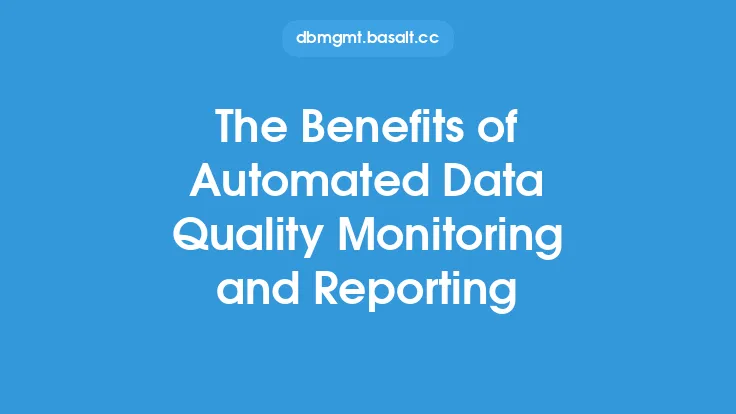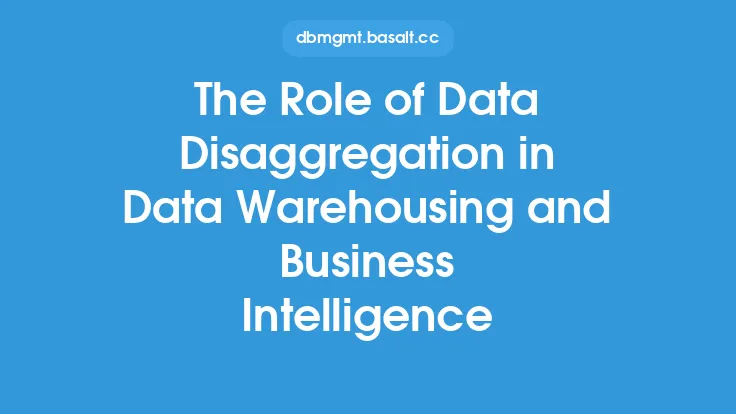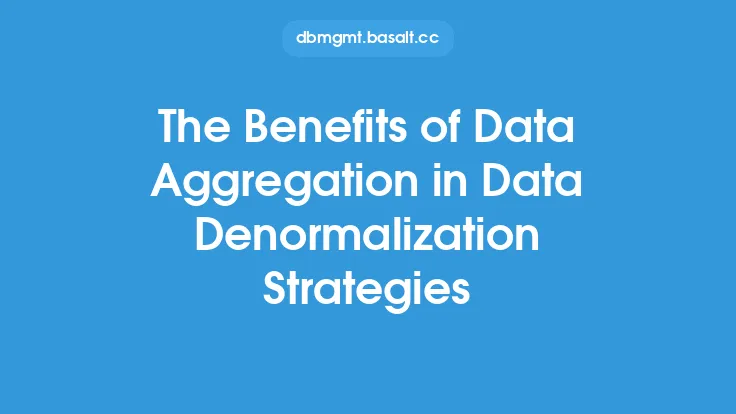In today's data-driven world, organizations are constantly seeking ways to improve their data analysis and reporting capabilities. One effective way to achieve this is by implementing a data warehousing solution. A data warehouse is a centralized repository that stores data from various sources in a single location, making it easier to access and analyze. By leveraging data warehousing, organizations can unlock the full potential of their data, gain valuable insights, and make informed decisions.
Introduction to Data Warehousing
Data warehousing is a process that involves collecting, storing, and managing data from multiple sources in a single repository. This repository is designed to support business intelligence activities, such as data analysis, reporting, and data mining. A data warehouse typically consists of three main components: a data source, a data storage system, and a data access tool. The data source can be any system that generates data, such as a customer relationship management (CRM) system, an enterprise resource planning (ERP) system, or a social media platform. The data storage system is the core of the data warehouse, where data is stored and managed. The data access tool is used to retrieve and analyze data from the data warehouse.
Benefits of Data Warehousing
The benefits of data warehousing are numerous and well-documented. Some of the most significant advantages include improved data analysis and reporting, enhanced data quality, and increased business intelligence. By storing data in a centralized repository, organizations can easily access and analyze data from multiple sources, gaining a more comprehensive understanding of their business operations. Data warehousing also enables organizations to identify trends, patterns, and correlations that may not be apparent from individual data sources. Additionally, data warehousing can help organizations to improve their data quality by providing a single, unified view of their data, which can help to eliminate data inconsistencies and errors.
Data Warehousing Architecture
A typical data warehousing architecture consists of several layers, including a presentation layer, an application layer, a data access layer, and a data storage layer. The presentation layer is the user interface, where users can access and analyze data. The application layer is where data is processed and transformed into a format that can be used for analysis. The data access layer is responsible for managing data access and retrieval. The data storage layer is where data is stored and managed. There are several data warehousing architectures, including the star schema, snowflake schema, and fact constellation schema. Each architecture has its own strengths and weaknesses, and the choice of architecture depends on the specific needs of the organization.
Data Warehousing Tools and Technologies
There are several data warehousing tools and technologies available, including relational databases, multidimensional databases, and cloud-based data warehousing solutions. Relational databases, such as Oracle and Microsoft SQL Server, are widely used for data warehousing due to their ability to handle large amounts of data and support complex queries. Multidimensional databases, such as Oracle Essbase and Microsoft Analysis Services, are optimized for data analysis and reporting, and are often used in conjunction with relational databases. Cloud-based data warehousing solutions, such as Amazon Redshift and Google BigQuery, offer a scalable and cost-effective alternative to traditional on-premises data warehousing solutions.
Data Warehousing and Business Intelligence
Data warehousing is a critical component of business intelligence, as it provides the foundation for data analysis and reporting. Business intelligence involves using data to gain insights and make informed decisions, and data warehousing provides the data and tools needed to support this process. By leveraging data warehousing, organizations can create a business intelligence framework that supports data-driven decision making, and helps to drive business success. Some common business intelligence tools and technologies include data visualization tools, such as Tableau and Power BI, and reporting tools, such as Crystal Reports and Microsoft Reporting Services.
Data Warehousing and Data Governance
Data warehousing is also closely related to data governance, as it involves managing and governing data across the organization. Data governance involves establishing policies and procedures for managing data, and ensuring that data is accurate, complete, and secure. By implementing a data warehousing solution, organizations can establish a single, unified view of their data, which can help to improve data governance and reduce the risk of data errors and inconsistencies. Some common data governance tools and technologies include data quality tools, such as Trillium and Informatica, and data security tools, such as encryption and access control.
Best Practices for Implementing a Data Warehouse
Implementing a data warehouse requires careful planning and execution, and there are several best practices that organizations can follow to ensure success. Some of these best practices include defining clear business requirements, establishing a data governance framework, and selecting the right data warehousing tools and technologies. Organizations should also consider the scalability and flexibility of their data warehousing solution, as well as the need for data quality and data security. Additionally, organizations should establish a data warehousing team that includes data architects, data engineers, and data analysts, and provide ongoing training and support to ensure that the data warehouse is used effectively.
Conclusion
In conclusion, data warehousing is a powerful tool for improving data analysis and reporting, and can help organizations to gain valuable insights and make informed decisions. By leveraging data warehousing, organizations can unlock the full potential of their data, and drive business success. Whether you are a seasoned data professional or just starting to explore the world of data warehousing, there are many resources available to help you get started, including online tutorials, training courses, and industry conferences. By following best practices and staying up-to-date with the latest trends and technologies, organizations can ensure that their data warehousing solution is effective, efficient, and scalable, and provides a strong foundation for business intelligence and data-driven decision making.





